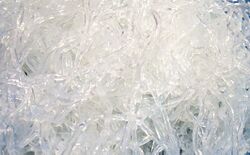Biology:Kelp noodles
 | |||||||
| Alternative names | Cheon Sa Chae, Angel threads, Angel noodles | ||||||
|---|---|---|---|---|---|---|---|
| Type | Noodles | ||||||
| Region or state | East Asia | ||||||
| Main ingredients | Alginic acid from kelp | ||||||
| 6[citation needed] kcal | |||||||
| |||||||
Kelp noodles or cheon sa chae (Korean: 천사채),[1] are semi-transparent noodles made from the jelly-like extract left after steaming edible kelp. They are made without the addition of grain flour or starch.[2] Kelp noodles have a crunchy texture and are low in calories.[3] They can be eaten raw, in salads, but for added taste, some prefer to cook them in water with spices added for flavoring.[citation needed] Many restaurants serve kelp noodles in stir fry dishes. The noodles usually require rinsing before being added to a stir fry dish towards the end of cooking time.
Nutrition
Kelp noodles are cholesterol, fat, and gluten-free, and also rich in nutrients.[4] A 1/2 cup serving includes 186 milligrams of sodium, 134 milligrams of calcium, 2.28 milligrams of iron, and 52.8 micrograms of vitamin K.[5] They are a good dietary source of iodine. Consumers with thyroid and heart disease should take the sodium and iodine content into account.[citation needed]
Dishes
Kelp noodles are mostly prepared in various Asian cuisine as a low-carbohydrate substitute for rice and pasta.[6] They are commonly used in soups, salads, stir-fries and vegetable side dishes. Since they have a neutral taste they take on the flavors of the dishes to which they are added. The noodles can be purchased online or in health food supermarkets, and restaurants are beginning to offer kelp noodles as an alternative to more traditional noodles or rice in their dishes.[citation needed]
Potential economic impact
The popularity of kelp noodles among health-conscious consumers is growing because of the rising demand for gluten-free food products.[7]
References
- ↑ "Seaweed Jelly Noodles – Aeri's Kitchen". aeriskitchen.com. http://aeriskitchen.com/2008/12/cheonsachae-%EC%B2%9C%EC%82%AC%EC%B1%84/.
- ↑ Wong, Cathy. "Kelp Noodles: What You Need to Know About Kelp Noodles". about.com. http://altmedicine.about.com/od/rawfooddiet/a/Kelp-Noodles.htm.
- ↑ (in ko). Doosan Encyclopedia. http://www.encyber.com/search_w/ctdetail.php?masterno=798768&contentno=798768.[yes|permanent dead link|dead link}}]
- ↑ Amerman, Don. "Nutritionally What Is Kelp Good For?". Demand Media. http://healthyeating.sfgate.com/nutritionally-kelp-good-for-3157.html.
- ↑ Billings-Smith, Lana. "What Are the Health Benefits of Kelp Noodles?". http://www.livestrong.com/article/273227-what-are-the-health-benefits-of-kelp-noodles/.
- ↑ Paleo-inspired kelp noodle recipes, Feb 9, 2011. Retrieved Mar 20, 2015,
- ↑ Gluten-Free Market Trends , Jan 1, 2012. Retrieved March 20, 2015.
Further reading
- Ladd, Chris (April 29, 2009). "Kelp: something different from the sea". Boston Globe. http://www.boston.com/lifestyle/food/articles/2009/04/29/kelp_something_different_from_the_sea/.
- Pete Evans (2014). Healthy Every Day. Pan Macmillan Australia. p. 259. ISBN 978-1-74351-790-1. https://books.google.com/books?id=goOMBAAAQBAJ&pg=PA259.
- Jessica Nadel (2015). Greens 24/7. Experiment LLC. p. 14. ISBN 978-1-61519-227-4. https://books.google.com/books?id=MvphBQAAQBAJ&pg=PA14.
 |

